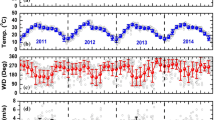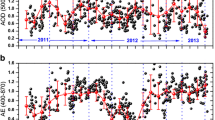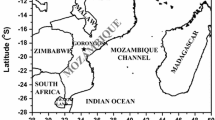Abstract
First time observations of spectral aerosol optical depths (AODs) at Mohal (31.9°N, 77.11°E; altitude 1154 m amsl) in the Kullu valley, located in the northwestern Indian Himalayan region, have been carried out during Integrated Campaign for Aerosols, gases and Radiation Budget (ICARB), as a part of the Indian Space Research Organisation-Geosphere Biosphere Program (ISRO-GBP). AODs at six wavelengths are obtained using Microtops-II Sunphotometer and Ozonometer. The monthly mean values of AOD at 500 nm are found to be 0.27 ± 0.04 and 0.24 ± 0.02 during March and April, 2006 respectively. However, their monthly mean values are 0.33 ± 0.04 at 380 nm and 0.20 ± 0.03 nm at 870 nm during March 2006 and 0.31 ± 0.3 at 380 nm and 0.17 ± 0.2 at 870 nm during April 2006, showing a gradual decrease in AOD with wavelength. The Ångstrom wavelength exponent ‘α’ had a mean value of 0.72 ± 0.05, implying reduced dominance of fine particles. Further, the afternoon AOD values are higher as compared to forenoon values by ∼ 33.0% during March and by ∼ 9.0% during April 2006 and are attributed to the pollutant lifted up from the valley by the evolving boundary layer. Besides the long-range transportation of aerosol particles by airmass from the Great Sahara and the Thar Desert regions to the observing site, the high values of AODs have also been influenced by biomass burning and frequent incidents of forest fire at local levels.
Similar content being viewed by others
References
Ångstrom A 1964 Techniques of determining the turbidity of the atmosphere; Tellus 13 214–223.
Beegum S Naseema, Moorthy K K, Nair V S, Babu S S, Satheesh S K, Vinoj V, Reddy R R, Gopal K R, Badarinath K V S, Niranjan K, Pandey S K, Behera M, Jeyaram A, Bhuyan P K, Gogoi M M, Singh S, Pant P, Dumka U C, Kant Y, Kuniyal J C and Singh D 2008 Characteristics of spectral aerosol optical depths over India during ICARB; J. Earth Syst. Sci. 117(S1) 303–313.
Bhuyan P K, Gogoi M M and Moorthy K K 2005 Spectral and temporal characteristics of aerosol optical depth over a wet tropical location in North East India; Adv. Space Res. 35 1423–1429.
Census of India 2001 Provisional Population Totals — Part 2; Director of Census Operations, Government of Himachal Pradesh, Shimla, pp 1–79.
Charlson R J, Schwartz S E, Hales J M, Cess R D, Coakley Jr J A, Hansen J E and Hoffmann D J 1992 Climate forcing by anthropogenic aerosols; Science 255 423–430.
Draxler R R and Rolph G D 2003 HYSPLIT (Hybrid Single-Particle Lagrangian Integrated Trajectory) software, NOAA; Air Resour. Lab., Silver Spring, Md. (available at http://www.arl.noaa.gov/ready/hysplit4.html).
Gogoi M M, Bhuyan P K and Moorthy K K 2007 Possible impact of a major oil-well fire on aerosol optical depth at Dibrugarh; Curr. Sci. 92(8) 1047–1049.
Ichoku C, Levy R, Kaufman Y J, Remer L A, Li R-R, Martins V J, Holben B N, Abuhassan N, Slutsker I, Eck T F and Pietras C 2002 Analysis of the performance characteristics of the five-channel Microtops II Sun photometer for measuring aerosol optical thickness and precipitable water vapor; J. Geophys. Res. 107(D13) 4179, doi:10.1029/2001JD001302.
IPCC 2001 International Panel on Climate Change (IPCC); The Scientific Basis, Cambridge University Press, New York.
Jayaraman A 2001 Aerosol radiation cloud interactions over the tropical Indian Ocean prior to the onset of the summer monsoon; Curr. Sci. 81(11) 1437–1445.
Kuniyal J C, Thakur Alpana, Tripathi Smita, Thakur H K, Sharma S, Oinam S S, Pant P, Hegde P and Dumka U C 2006 Aerosols characteristics at high altitude locations of Kullu-Manali in the northwestern Himalaya during ICARB; In: Proc. First Post-Campaign meeting of ICARB & Meeting of the WG-II of ISRO-GBP, Geosphere Biosphere Programme (I-GBP). Space Physics Laboratory, VSSC, Thiruvanthpuram, October 25–27, pp 1–232.
Kuniyal J C and Vishvakarma S C R 2006 Changing behaviour of ambient air quality and surface ozone in hill spots: a case study of Kullu-Manali Tourist Complex (KMTC), Northwestern Himalaya; DST final technical report submitted to the Department of Science & Technology, Govt. of India, November 2006, pp 1–36.
Morys M, Mims F M III, Hagerup S, Anderson S E, Baker A, Kia J and Walkup T 2001 Design calibration and performance of Microtops II handheld ozone monitor and Sun photometer; J. Geophys. Res. 106(D13) 14,573–14,582.
Moorthy K K, Niranjan K, Narasimhamurthy B, Agashe V V and Murthy B V K 1999 Aerosol climatology over India; 1-ISRO-GBP MWR network and database, ISRO-GBP SR-03-99.
Pant P, Hedge P, Dumka U C, Saha A, Srivastava M K and Sagar R 2006a Aerosol characteristics at a high-altitude location during ISRO-GBP Land campaign-II; Curr. Sci. 91(8) 1053–1061.
Pant P, Hegde P, Dumka U C, Sagar R, Satheesh S K, Moorthy K K, Saha A and Srivastava M K 2006b Aerosol characteristics at a high-altitude location in central Himalayas: Optical properties and radiative forcing; J. Geophys. Res. 3 D17206, doi: 10.1029/2005JD006768.
Sagar R, Kumar B, Dumka U C, Moorthy K K and Pant P 2004 Characteristics of aerosol optical depths over Manora Peak: A high altitude station in the central Himalaya; J. Geophys. Res. 109 006207, doi: 10.1029/2003JD003954.
Satheesh S K, Moorthy K K and Das I 2001 Aerosol spectral optical depths over the Bay of Bengal, Arabian Sea and Indian Ocean; Curr. Sci. 81 16–18.
Shaw G E 1976 Error Analysis of Multi-wavelength Sun Photometry; Pure Appl. Geophys. 114 1–14.
Shaw G E, Reagan J A and Herman B M 1973 Investigations of atmospheric extinction using direct solar radiation measurements made in the multiple wavelength radiometer; J. Appl. Meteorol. 12 374–380.
Singh S and Singh R 2004 High altitude clear sky direct solar ultraviolet irradiance at Leh and Henle in the western Himalayas: Observations and model calculations; J. Geophys. Res. 109 D19201, doi 10.1029/2004JD 004854.
Srivastava M K, Singh S, Saha A, Dumka U C, Hegde P, Singh R and Pant P 2006 Direct solar ultraviolet irradiance over Nainital, India, in the central Himalaya for clear-sky day conditions during December 2004; J. Geophys. Res. 111 D08201.
Author information
Authors and Affiliations
Corresponding author
Rights and permissions
About this article
Cite this article
Kuniyal, J.C., Thakur, A., Thakur, H.K. et al. Aerosol optical depths at Mohal-Kullu in the northwestern Indian Himalayan high altitude station during ICARB. J Earth Syst Sci 118, 41–48 (2009). https://doi.org/10.1007/s12040-009-0004-y
Received:
Revised:
Accepted:
Published:
Issue Date:
DOI: https://doi.org/10.1007/s12040-009-0004-y




